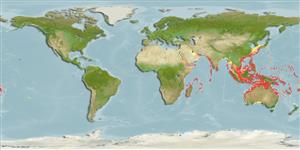Classification / Names
Common names | Synonyms | Catalog of Fishes (gen., sp.) | ITIS | CoL | WoRMS | Cloffa
Actinopterygii (ray-finned fishes) >
Perciformes (Perch-likes) >
Apogonidae (Cardinalfishes) > Apogoninae
Environment / Climate / Range
Ecology
Marine; reef-associated; depth range 2 - 128 m (Ref. 58479), usually 15 - 30 m (Ref. 90102). Tropical, preferred ?
Indo-West Pacific: Red Sea and Persian Gulf south to Mozambique and east to the western Pacific where it ranges from Japan to Sydney (Ref. 11411). Recorded from the Eastern Mediterranean (Ref. 93672).
Size / Weight / Age
Maturity: Lm ? range ? - ? cm
Max length : 10.3 cm TL male/unsexed; (Ref. 11441); common length : 7.0 cm SL male/unsexed; (Ref. 37816)
Dorsal
spines
(total): 8;
Dorsal
soft rays
(total): 9;
Anal
spines: 2;
Anal
soft rays: 8. Characterized by having generally white to dusky pinkish body color; 3-4 dark stripes on upper half of body; presence of broad, uniform midlateral stripe continued to caudal fin; narrower stripe above eye to upper caudal peduncle; base of dorsal fin to upper caudal peduncle with thin stripe; incomplete diffuse stripe above midlateral strip; greatest depth of body 2.6-2.7 in SL (Ref. 90102).
Inhabits coastal reefs, in sandy or weedy areas (Ref. 9710). Nocturnal. Juveniles often occur with sea anemones (Ref. 37816).
Life cycle and mating behavior
Maturity | Reproduction | Spawning | Eggs | Fecundity | Larvae
Mouthbrooders (Ref. 240). Distinct pairing during courtship and spawning (Ref. 205).
Paxton, J.R., D.F. Hoese, G.R. Allen and J.E. Hanley, 1989. Pisces. Petromyzontidae to Carangidae. Zoological Catalogue of Australia, Vol. 7. Australian Government Publishing Service, Canberra, 665 p. (Ref. 7300)
IUCN Red List Status (Ref. 115185)
CITES (Ref. 94142)
Not Evaluated
Threat to humans
Harmless
Human uses
Fisheries: of no interest
More information
ReferencesAquacultureAquaculture profileStrainsGeneticsAllele frequenciesHeritabilityDiseasesProcessingMass conversion
Tools
Special reports
Download XML
Internet sources
